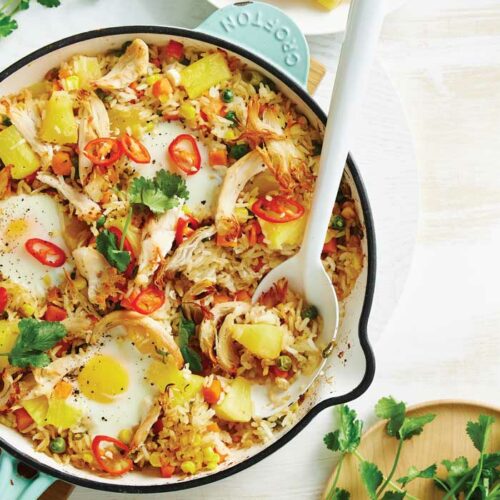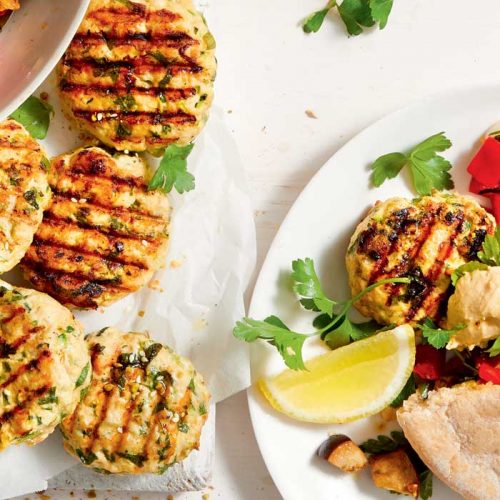
Yes, you can have your cake and eat it, too! Dietitian Brooke Delfino shows you how to enjoy treats as part of a healthy diet.
Do you often turn down a slice of cake or a piece of chocolate, only to find you can’t stop thinking about it? You know what happens next. Not only do you eventually succumb to the craving, you end up overindulging, then feel sick and full of regret afterward. This common cycle stops you from taking pleasure in foods you’re meant to enjoy.
Eating foods purely for pleasure — because they taste delicious — is not a bad thing. And there’s also no such thing as ‘good’ or ‘bad’ foods either. Instead, it’s all about how much and how often you eat them. Read on to discover how you can make treat foods a part of your healthy diet.
How do treats fit into my diet?
What’s a birthday without cake? Or a celebration without a flute of fizzy champagne? And who wants to swelter through summer without ice-cream? The point is, beyond providing good nourishment for our body, the foods we eat are very much part of our social and cultural environment.
Purely from a health perspective, high-kilojoule treat foods, soft drinks and alcoholic beverages are not essential to a healthy diet because they provide very few of the nutrients our body needs. Unfortunately, the startling news from the most recent National Nutrition and Physical Activity Survey is that around a third of our kilojoule intake is coming from these treat (or discretionary) foods.
To put this into perspective, that’s a whole meal completely made up of treat foods and beverages. These foods are meant to add pleasure to a healthy, balanced diet, not become a third of our food intake. Yet banning these foods isn’t the answer, since we know that denying ourselves something we want to eat only makes us crave it more.
The good news is that we can enjoy discretionary foods if we understand exactly what moderation means. But the problem is that many of us have difficulty understanding how to limit the foods we’re so often told to eat in moderation.
Making sense of moderation
According to dietary guidelines, a healthy serve of discretionary food is 600kJ (143cal). To reap the most nutritional reward from our diet, we need to ensure our meals are based on the five food groups: fruit, vegetables, whole grains, dairy foods and lean meats. Most of us don’t have much room left for the empty kilojoules of discretionary food, but if you stick to a specific number of serves, you can include these foods in your healthy eating plan.
Our visual guide (below) shows you how to enjoy all your favourite treats in a way that won’t disrupt your healthy diet or lead to weight gain.
What’s considered a discretionary food?
We call them treats or snacks, and sometimes even ‘junk food’, but Australian Dietary Guidelines describe food and drinks that are high in sugar, salt and saturated fat — and therefore kilojoules — as discretionary foods (DF). We’re talking biscuits, pastries, pies, ice cream, most deep-fried foods, chocolate, soft drinks and even alcoholic beverages.
And before you take a bite of that raw vegan brownie or protein power ball, many so-called health foods are also discretionary foods because they can be high in sugar and saturated fat, which means they’re extremely high in kilojoules. Although their nutritional profile is slightly better, we still need to still think of them as occasional treats.
One serve of discretionary food should deliver 600kJ (143cal). But, as you’ll discover from our visual guide (below), many cakes, chocolates and chips have three to four times that amount. Armed with this knowledge, you’ll be able to make smarter choices and live your life without depriving yourself of your favourite foods.
How often can I eat treat foods?
The number of serves of discretionary foods you can have each day depends on three factors: your weight, height and level of physical activity. Most people in the healthy weight range with a low-to-medium activity level can enjoy one or two treat foods a day. This includes those who sit all day at work and people who exercise for about an hour each day.
However, if you’re tall, have a more active job and are a healthy weight, you can choose to spend your extra kilojoules on up to three serves of treat foods a day.
How to curb cravings
Why do we crave chocolate and potato crisps, but never salad? What makes these highly processed foods so irresistible?
The answer is they are all rich in fat and sugar or salt, and low in fibre. They also have a high glycaemic load, meaning they are rapidly absorbed into the bloodstream and create high spikes in blood sugar, which is linked to ‘addictive-like’ eating, according to researchers.
Put simply, these foods leave our tastebuds longing for more, and override our innate ‘I’ve had enough’ signals.
To help curb cravings, be aware of what’s happening and know that you can override the feeling. Before you indulge your craving, ask yourself whether you are truly hungry or whether the craving is a result of something else — are you actually bored, tired or upset?
Sometimes, taking a moment to pause and ask yourself, ‘Am I really hungry?’ is all it takes to stop cravings in their tracks.
Another tip is to keep healthy foods within easy reach such as fresh fruit in the fruit bowl, veggies cut up in the fridge or nuts in a container on your work desk.
Yes, you can eat that treat!
Use this guide to enjoy all the foods you love in a healthy way.
4 tips to avoid overeating
- Always ask yourself, “Am I really hungry?”
- Base your main meals around lean proteins, wholegrain carbohydrates and lots of vegetables.
- Keep a nutritious snack, such as a high-fibre muesli bar, on hand for when you need to refuel.
- Don’t keep foods that you tend to eat too much of in the house.



Article sources and references
- CSIRO. 2021. New CSIRO tool to combat Australia’s #1 diet issue. Accessed July 2021https://www.csiro.au/en/news/news-releases/2021/new-csiro-tool-to-combat-australia-1-diet-issue
- Fayet-Moore, F & Pearson, S. 2015. Interpreting the Australian dietary guideline to “limit” into practical and personalised advice. Nutrients. 7(3): 2026–43https://www.ncbi.nlm.nih.gov/pmc/articles/PMC4377898/
- National Health and Medical Research Council. 2017. Discretionary food and drink choices. Accessed July 2021https://www.eatforhealth.gov.au/food-essentials/discretionary-food-and-drink-choices
www.healthyfood.com










